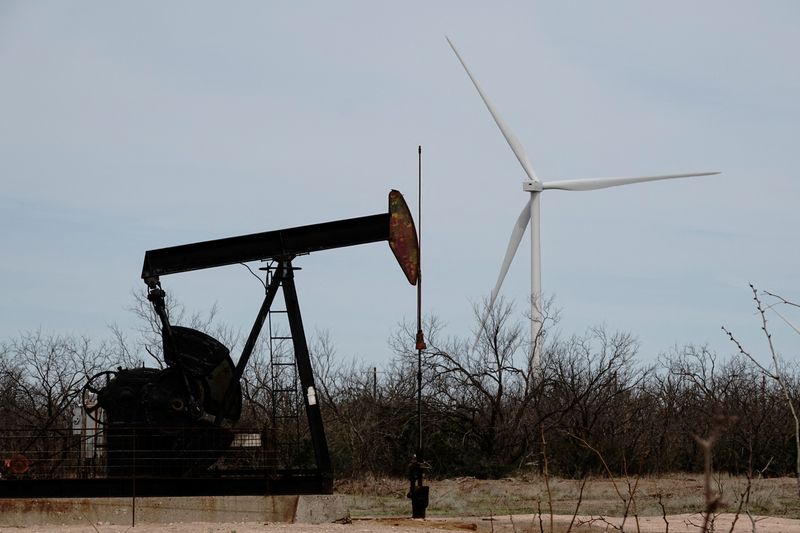By Liz Hampton
(Reuters) - U.S. crude oil prices last week climbed to their highest this year, but a weak natural gas market, steeper costs and a focus on shareholder returns over new production are keeping shale drillers from big output increases in the world's top oil and gas producer.
The global Brent oil benchmark last week was trading above $91 a barrel, while in the U.S., West Texas Intermediate (WTI) futures were over $86 a barrel, their highest since October. [O/R]
The price gains reflect supply risks from attacks on Russian oil infrastructure and global shipping, as well as ongoing output cuts by the Organization of the Petroleum Exporting Countries and allies (OPEC+).
Bank of America in early April increased its 2024 Brent and WTI price outlook to $86 and $81 per barrel, respectively, and said both were likely to peak around $95 a barrel this summer.
Those higher prices so far have not been enough to entice U.S. drillers to boost production, operators and service firm executives said, as many are grappling with a steep decline in the value of gas produced alongside their oil.
In Texas, Louisiana and New Mexico, producers were already cutting output in the first quarter as costs climbed. The breakeven price to drill a new well in the Permian, the top U.S. shale field, rose $4 per barrel in the last year, according to a survey by Federal Reserve Bank of Dallas.
Now, low gas prices are creating new challenges.
Henry Hub futures, the benchmark for U.S. gas, are trading below $1.80 per million British thermal unit (mmBtu), and earlier this year dropped to a 3-1/2-year low on warm weather and oversupply.
"We need gas prices to get to $2.50 for an overall increase in activity. The Permian customers that have associated gas are seeing awful differentials," said Mark Marmo, CEO of oilfield firm Deep Well Services.
In West Texas producers are paying to have shippers to take their gas. Prices at the region's Waha hub have been below zero in several trade sessions since March, a sign that supply is sharply outpacing demand and pipeline capacity.
Producers can respond by reducing their output or pay to keep pulling gas out of the ground.
"Constrained gas pipeline and gas processing plant capacity has acted as a choke point on oil production in parts the Permian Basin," said Tim Roberson, president of Permian producer Texas Standard Oil.
"If oil prices are high enough, the gas price becomes less of a consideration in the overall drilling economics," he added.
RIGS PLATEAU
U.S. oil production is expected to grow by 260,000 barrels per day (bpd) this year, to a record 13.19 million bpd, but far behind the over 1 million bpd of growth it saw between 2022 and 2023, according to the U.S. Energy Information Administration.
U.S. shale production has persistently exceeded recent estimates, but market analysts have not been tempted to raise their growth forecasts in response to higher prices.
Energy tech firm Enverus, this week said it sees U.S. production rising 255,000 bpd this year.
"Rig activity levels continue to plateau suggesting that these price levels have not generated an activity response," said Alex Ljubojevic, an analyst with Enverus.
The U.S. oil drilling rig count last week was at 508, down 82 from year-ago levels, while the number of active gas rigs was at 110, its lowest since January 2022, according to data from Baker Hughes.
Less access to financing and investor pressures to deliver higher returns also are restraining oil production expansions, said Brad James, CEO of contract driller Enterprise Offshore Drilling.
Potential fees on producers for methane releases above certain thresholds are being watched closely by producers as another cost. The fees would start this year at $900 per metric ton and rise to $1,500 per ton in 2026.
"The methane detection enforcement procedures for small producers is a looming crisis," one energy executive told a Dallas Fed survey last month.

In all, 80% of the 129 executives surveyed by the Dallas Fed said the methane fee was slightly or significantly negative to their business.
"Access to capital is limited because of ESG (environmental, social and governance), politics, energy transition, bias against fossil fuels," James added. "The result of diminished access to capital is that our clients exhibit much more capital discipline than they did in years past."